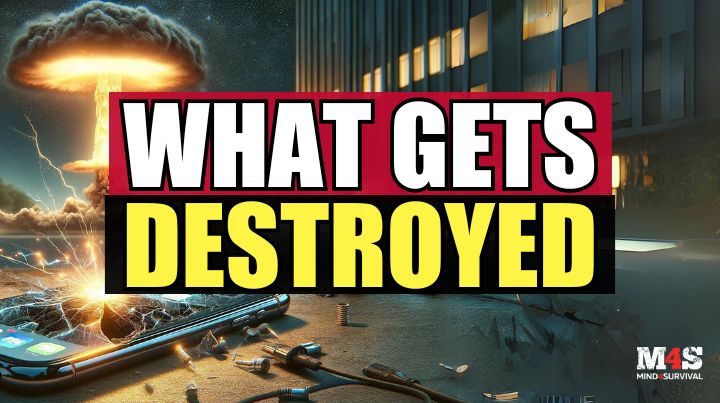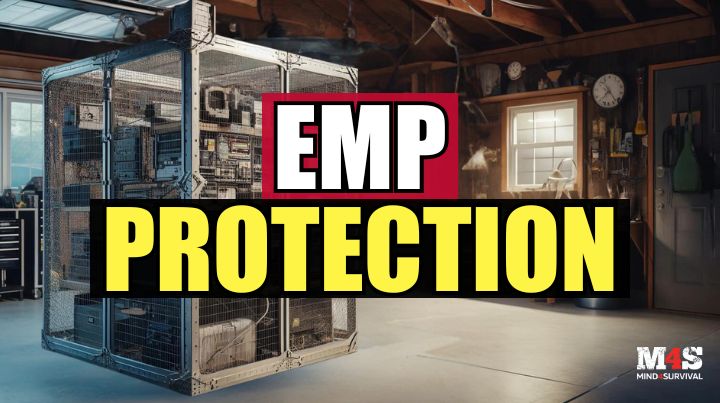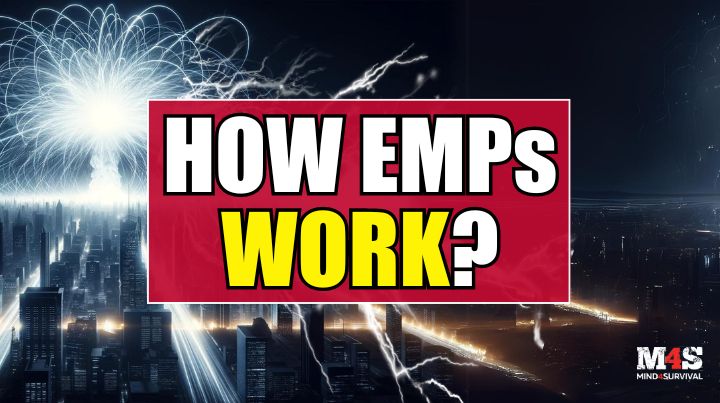In a world increasingly dependent on technology, the concept of an Electromagnetic Pulse (EMP) carries significant weight. Understanding how a nuclear EMP works is crucial, not just for scientists and engineers but for anyone concerned about the resilience of our modern infrastructure. I had the privilege of discussing this topic with Dr. Arthur Bradley, an expert in EMP phenomena, to shed light on the complexities and implications of EMPs on our electronic systems.
In this article, I unravel the complexities of Electromagnetic Pulses (EMPs) through the lens of Dr. Arthur Bradley, a distinguished authority in the field. Leveraging his extensive background in EMP research, engineering, and work with NASA, Dr. Bradley illuminates the in-depth nature of EMP threats and underscores the vital importance of being prepared.
Given the state of the modern world and the possibility of an EMP attack, understanding EMPs is essential for preparedness-minded people. Read this article to learn the science behind how EMPs work.
Quick Look at What You’ll Learn
Electromagnetic Pulse Explained
An EMP is a burst of electromagnetic energy capable of disrupting or damaging electronic devices and electrical systems across vast areas. This phenomenon can originate from various sources, including nuclear detonations in the Earth’s atmosphere. Dr. Bradley elaborates on the process: a nuclear explosion at high altitudes above the Earth’s atmosphere generates gamma rays. These rays ionize electrons in air molecules, producing electron flows that interact with the Earth’s magnetic field, ultimately leading to the generation of electromagnetic pulses.
Electromagnetic Energy and Its Effects
The surge of electromagnetic energy unleashed by an EMP has the potential to affect everything from personal electronics to the extensive power grid. Grasping how this high-energy electromagnetic pulse first interacts with our electronic and other electrical equipment is crucial for minimizing damage and fortifying our infrastructure, both individually and societally, against such unpredictable and devastating events. This understanding not only aids in immediate response strategies but also long-term planning for enhanced resilience in our increasingly digital world.
Nuclear Electromagnetic Pulse: A Closer Look
A nuclear electromagnetic pulse (EMP), triggered by an atmospheric nuclear explosion, poses a complex threat characterized by its E1, E2, and E3 phases. Dr. Arthur Bradley particularly highlights the E3 phase’s ability to severely disrupt large-scale electrical systems, underscoring the urgent need for comprehensive preparedness and robust protection strategies to mitigate this risk. This insight into the nuanced nature of nuclear EMPs is critical for preparing to face this electromagnetic calamity.
The Three Phases of an EMP Attack
Dr. Bradley breaks down the EMP event into three distinct phases: E1, E2, and E3. The impact of an electromagnetic pulse on electronic devices is not uniform. It varies widely depending on several factors, including the intensity of the EMP and the devices’ vulnerability.
The E1 & E2 Phases
The initial phase of an EMP, known as E1, is characterized by a rapid, high-voltage surge capable of causing immediate and catastrophic damage to electronic equipment and circuits. This phase of the electromagnetic pulse is particularly destructive because it happens so quickly—within nanoseconds—that it can permanently disable or destroy electronic devices before any protective measures can react. Devices with delicate electronic components, such as smartphones, computers, and modern vehicle’ control systems, are especially at risk during this phase.
However, the scenario is not the end for all electronics. Some devices may be less affected by the E1 phase due to inherent design characteristics that offer a degree of natural resistance to electromagnetic interference. Additionally, devices that are turned off or disconnected from larger networks at the time of the EMP may have a higher chance of surviving the pulse. Following the E1 phase, the subsequent E2 phase resembles a lightning strike, which can increase the damage received from the E1.
The E3 Phase
The last phase, the E3 phase, creates a wave of energy that creates something akin to that of a CME. While it can pose a threat to the power grid and long-line communication networks, it has little effect on fine electronic equipment, such as cars or cell phones, which are affected by the E1 and E2 phases. The variability in the EMP’s effects, depending on the phase, underscores the importance of understanding the specific vulnerabilities of different types of electronic equipment and the necessity of implementing protective measures tailored to mitigate these risks.

How Long Would an EMP Last?
The initial phases of an EMP event are brief, with the initial E1 and E2 phases lasting just fractions of a second. By comparison, the E3 phase, such as when in the form of a coronal mass ejection, can last hours or longer. Regardless of the length of the event, its after-effects on the electrical grid can persist, leading to prolonged power outages and societal disruptions.
In that case, recovering from such an event could require extensive repairs and replacements of critical infrastructure components, potentially taking months or even years. This long-term disruption underscores the importance of effective EMP preparedness and resilience planning for essential services and infrastructure.

Does an EMP Permanently Destroy Electronics?
The impact of an EMP on electronics varies. The E1 phase can permanently damage or destroy electronic devices by overwhelming them with a swift, high-voltage surge. However, not all electronics will be affected equally, and some may remain functional or require repairs to return to operation.
Factors such as the device’s proximity to the EMP source, its design, the angle of the electronic equipment to electromagnetic radiation, and the presence of any shielding can influence the extent of damage. Regardless, electronics that are damaged or destroyed by an EMP will remain that way unless repaired.
Would an EMP Stop a Car?
Modern vehicles, due to their reliance on electronic systems, could be vulnerable to an EMP. The E1 phase could damage a car’s electronics, potentially stopping it. However, the extent of vehicle damage would depend on the vehicle’s design, positioning in relation to the EMP, and the EMP’s strength.
It’s worth noting that older cars with fewer electronic components may be less affected, offering some resilience to EMP effects. Additionally, manufacturers are increasingly aware of EMP risks, prompting research into more EMP-resistant vehicle designs and after-market parts.

Protecting Against EMPs
Dr. Arthur Bradley is a strong and well-versed advocate for the critical necessity of readiness for an Electromagnetic Pulse (EMP) event. It’s not just about understanding the science behind EMPs but actively taking steps to shield the lifeblood of our society—our critical infrastructure. This encompasses a broad spectrum, from the electrical grids that power our cities to the communication networks that keep us connected.
Developing technologies that can withstand the abrupt and intense electromagnetic forces unleashed by an EMP is critical. Moreover, implementing effective shielding solutions, such as Faraday cages for smaller devices and more robust protective measures for larger systems, is indispensable. These actions form the bedrock of a strategy aimed at preserving the functionality of our electronic and electrical systems in the face of EMP threats.
Beyond the technical measures, Dr. Bradley also highlights the importance of a holistic approach to EMP preparedness. This includes policy-making that supports the funding and development of EMP-resistant infrastructure, public awareness campaigns to educate on the risks and responses to EMP events, and regional cooperation to address this challenge.
Ultimately, the goal is to create a resilient framework where critical services can withstand an EMP’s effects or recover swiftly, minimizing the impact on society.
What Material Can Block an EMP?
Protecting electronics from an EMP’s potentially devastating effects is a critical consideration. The principle behind protecting electronics involves using materials that can either absorb or deflect the electromagnetic energy generated by an EMP—preventing it from reaching and damaging sensitive electronic components.
Copper and Aluminum
Conductive materials, notably copper and aluminum, are particularly effective in this role. If used properly, these metals can create a Faraday cage effect, forming a shielded enclosure that intercepts electromagnetic fields. Encasing electronic devices, equipment or infrastructure in these materials can significantly reduce the risk of EMP-induced damage. This method is not just theoretical but has practical applications in safeguarding everything from individual consumer electronics to critical national infrastructure.
Beyond basic conductive materials, developing specialized EMP shielding enclosures represents a sophisticated approach to EMP protection. These enclosures are designed to defend against the high-intensity electromagnetic fields generated by EMP attacks.
They vary in complexity and size, from small bags and cases meant for personal electronics to large-scale installations that can protect entire rooms or buildings. The effectiveness of these enclosures depends on several factors, including the material’s conductivity, the enclosure’s design, and the specific characteristics of the EMP threat.

The Bottom Line on How EMPs Work
The threat of an EMP, with its potential to severely disrupt our electronics, communications systems, and power grid, presents a significant challenge in our technology-driven world. Understanding EMPs and the necessity for preparedness and protective measures is vital. This knowledge is crucial for safeguarding our infrastructure and future against the possible devastating effects of EMPs, emphasizing the urgency of adopting EMP-resistant technologies and implementing effective shielding strategies.
Only by fostering awareness and taking proactive steps to enhance our resilience can we mitigate the impact of EMPs on our society. Unfortunately, the proactive steps to improving our resilience to grid-down events cannot solely rest with the preparedness community. Society as a whole must be involved.
What are your thoughts about EMPs and our current state of affairs? Tell us in the comments below.
Additional Resources
Stay safe,

Read the full article here





